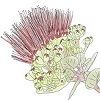7.1: Seedless vascular plants
- Page ID
- 59242
Seedless vascular plants reproduce via spores but, unlike non-vascular plants (hornworts, mosses, and liverworts) have a vascular system with xylem and phloem, which transport water and nutrients (Figure \(\PageIndex{1}\)). They do not produce flowers, fruits, or seeds. There are two major distinct evolutionary lineages: lycophytes (Lycopodiopsida) and ferns (Polypodiopsida) with approximately 12,000 species worldwide (PPG I, 2016). On an evolutionary scale, ferns are more closely related to seed plants than to lycophytes, but these two classes of plants are usually grouped as seedless vascular plants because they share several characteristics. These relationships are still being studied by evolutionary biologists and they will likely be clarified in the near future.

Lycophytes and ferns share a similar life cycle with independent photosynthetic gametophytes and sporophytes, with the sporophyte being the dominant phase. This is different from bryophytes, where the sporophyte grows from and remains attached to the gametophyte, and the gametophyte is dominant. The sporophytes of vascular plants are usually large and visible, having differentiated plant organs, as leaves, roots, and stems, while the gametophytes are small. Lycophytes have microphylls (leaves with single unbranched veins), while other vascular plants (ferns, gymnosperms, and angiosperms) have megaphylls (leaves with multiple branched veins).


